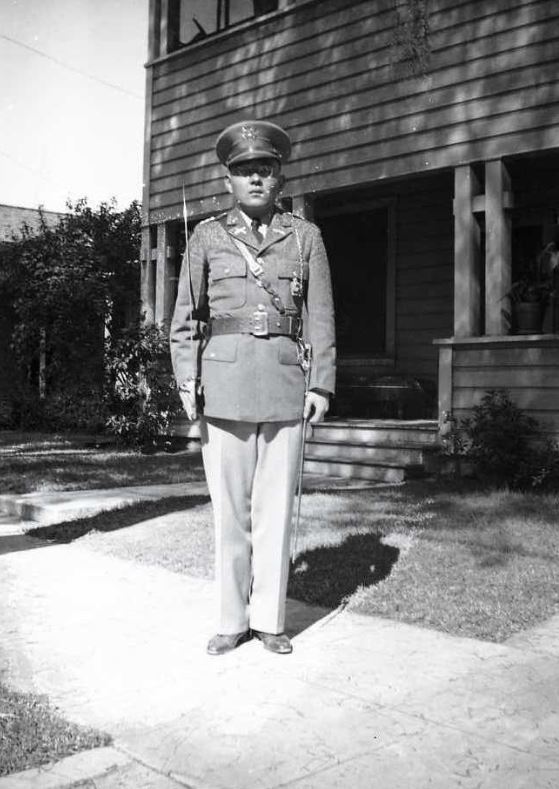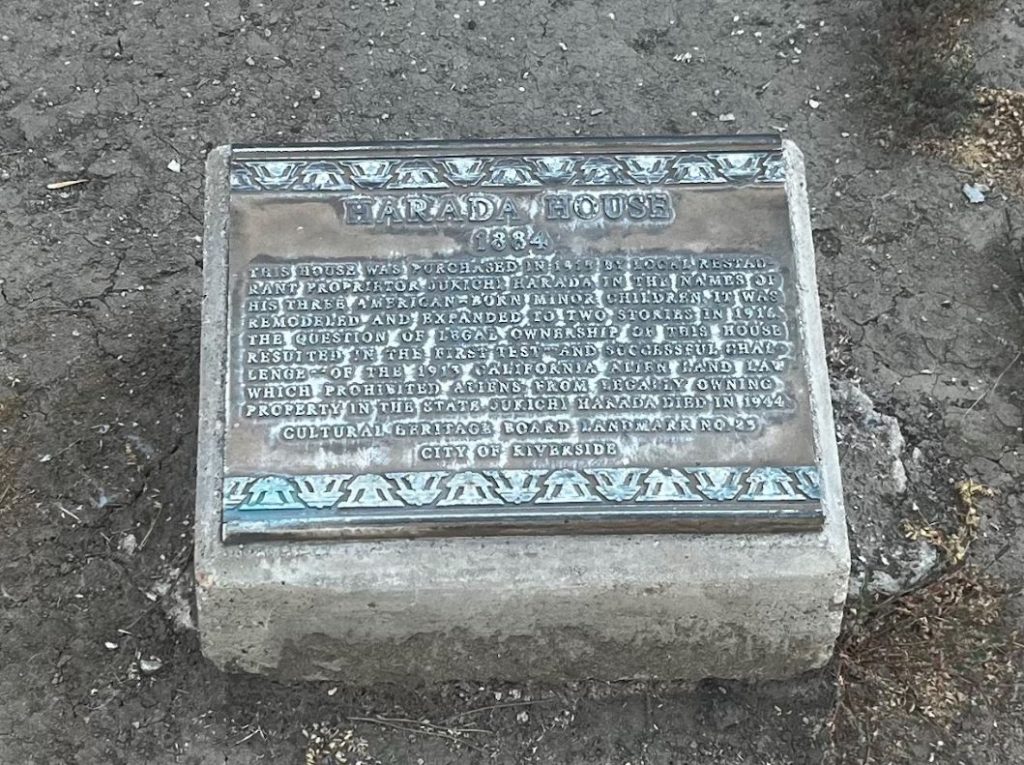By Kiyomi Casey
(This is part of our ongoing series, Lost Kinjo- a look at the more than 40 Japanese communities that disappeared after World War II. It is supported by funding from the California Public Library Civil Liberties Project and the Takahashi Family Foundation.)
Michiko Yoshimura: This is a special house.
Kiyomi Casey: The Harada House, a Japanese Historical Landmark in Downtown Riverside, is being restored by the Museum of Riverside.
The Harada family purchased the house in 1915, shortly after California had passed the Alien Land Law, which prevented immigrants from owning property.
Robyn Peterson, the Director of the Museum, has been overseeing the restoration project, and working to inform the public on the Harada family’s history.
Robyn Peterson: They heard about this house and immediately made an offer on it; what they didn’t reckon with was how hostile the neighbors would be to the idea of a Japanese American family moving into the neighborhood.
Kiyomi Casey: Japanese immigrants began moving to Riverside as early as the late 1800’s to work on citrus orchards. According to the US census, 76 Japanese people lived in Riverside County in 1900, by 1910 the population jumped to 765.
Jukichi and Ken Harada moved to Riverside around 1905. They ran what would be known as the Washington Restaurant and a few rooming houses. For years they lived on the second floor of a rooming house on the corner of Orange and 8th, but they bought a single-family home after their five-year-old son Tadao died from diphtheria.

In 1916, Cynthia Robinson, the woman who lived to the left of the Harada’s formed a committee with other homeowners and took the Harada family to court. Opening the case of The People of the State of California v. Jukichi Harada.
The committee tried to prove that the Harada family weren’t legally allowed to own property, but knowing the law, Harada had purchased the house under the names of his three American born children.
Robyn Peterson: Judge Hugh Craig and Riverside County Superior Court ruled that the 14th Amendment protected the American born children’s ownership rights, I think it would be hard for that not to happen. In 1918, September 18th the opinion came down that the family could stay in their house.
Kiyomi Casey: The family lived in that home until executive order 9066 was signed in 1942, leading to the incarceration of over 120,000 people of Japanese descent across the U.S. The Harada family was sent to three different incarceration camps, Tule Lake, Poston, and Topaz until three of the Harada children petitioned to join their parents in Topaz. During this time, they trusted a family friend to look after their home.

Robyn Peterson: Jeff Stebler, who had been a regular at the Washington restaurant, took on the not insignificant task of caring for the House, making sure the bills got paid. And so that made it possible for the House to be here.
Kiyomi Casey: The parents Jukichi and Ken Harada never returned to their home after the war as they died in the Topaz camp in Utah. Only their daughter Sumi returned to the house and opened it up as a boarding house to other Japanese incarcerees with nowhere to go. Sumi owned the house until her death in 2002. In 2004 the family transferred ownership to the City of Riverside. Where the Museum of Riverside would oversee its restoration.
Michiko Yoshimura began supporting the Harada House restoration project as a member of the Japanese American Citizens League and a friend of Sumi’s.
Michiko Yoshimura: Sumi was a charter member of our group. And so then naturally, you know, somebody was in our organization for all those, all those years. And so when she passed away the house was donated to them by the city of Riverside, you know, Riverside Jaycees, and it’s always been a big supporter of the Harada House.
Kiyomi Casey: The Harada House became protected as a historical landmark, but it had never been updated. This preserved the History of the building, but also meant it required a heavy restoration project before it could be open to the public.
Michiko Yoshimura: The house itself, because it’s so fragile, is a long-range project. And I believe we’ll see more work on the Robinson house.

Kiyomi Casey: The Robinson House next door, also under the care of the museum, is set to become an interpretive center. Opening the Robinson House will allow visitors to see the work being done to the Harada House. Visitors will need to come in small groups as the House still stands in a residential neighborhood.
Robyn Peterson: The thing that will help is that we can only take people through here in guided tours with a docent due to the size of the house. Two small groups at a time. We can’t give them parking space, so we’ll work it out. It’s not the first historic house. It’s hard to work out the challenge of operating here in a residential neighborhood.
Kiyomi Casey: The project has not been easy, but community members such as Yoshimura are dedicated to preserving Japanese American history and culture. Yoshimura moved to Riverside after the war ended and feels the Japanese community in Riverside is not what it used to be.
Michiko Yoshimura: With the Japanese after the war, you didn’t have, you know, Japanese coming into the United States. And so we haven’t had that much of immigration. It’s changing. You know, the Japanese American society now is quite different than, let’s say, 50 years ago, you know, when I was young.
Here at the local chapter, I mean, we have a small group of people that are, you know, that are the Sanseis (third generation). We’re not the Nisei (second generation) group because they’ve died out. And the Sansei group is hanging on. And we have difficulty trying to get new members to join.
Kiyomi Casey: Restoring the Harada House is a delicate process, but the work is being done because many Japanese families lost property during incarceration, leaving very little physical remnants of Japanese American history.
Michiko Yoshimura: I keep reading in the newspapers and magazines about so much which has been lost in telling the story of the Japanese Americans in California, because this is Riverside and one family lived in this house. If the house had been sold, it wouldn’t be here anymore. This is special, this house is still here.
Kiyomi Casey: While the House is not currently open to the public, it has signs outside for people who pass by to read about the history. Yoshimura pointed to each of these as she spoke about the importance of informing the public.

Michiko Yoshimura: The last time I came back here through that walk and I saw this and the symbol over here, and I saw that, I said, oh, how wonderful. So that when somebody is walking by the house, you know, they can stop and read the story. And it’s it helps to spread the news of what’s special about this place.

Kiyomi Casey: The Harada House is one of only two Historical Landmarks in Riverside, and the only national landmark that tells the story of an individual Japanese family. Peterson emphasizes the importance of preserving that history.
Robyn Peterson: We’re striving very hard to keep as much of the original fabric as we can to make that experience of this thing more authentic. Because, again, that notion of place is something you feel viscerally.
AsAmNews is published by the non-profit, Asian American Media Inc.
We’re now on BlueSky. You can now keep up with the latest AAPI news there and on Instagram, TikTok, Facebook, YouTube and X.
We are supported by generous donations from our readers and by such charitable foundations as the Robert Wood Johnson Foundation.
You can make your tax-deductible donations here via credit card, debit card, Apple Pay, Google Pay, PayPal and Venmo. Stock donations and donations via DAFs are also welcomed.



What an important story (with genuinely heroic participants) that deserves to be remembered, memorialized and taught, for a number of reasons. Thank you for sharing.